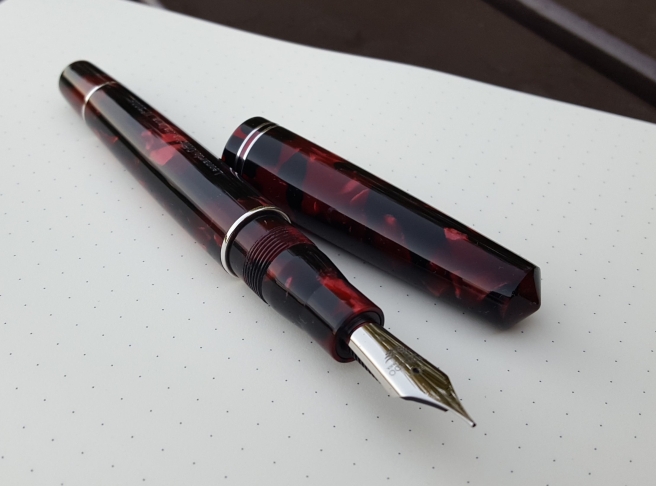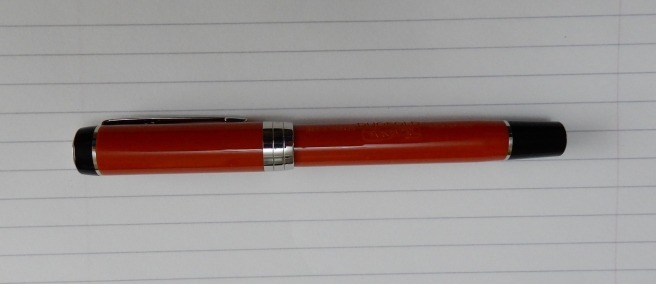
For a London based fountain pen addict, the annual London Pen Show is probably the biggest date in the calendar, for meeting dealers, fellow enthusiasts and some pen shopping. I had been looking forward to it for months.
It is sensible to have some sort of plan or list if you intend to buy something, as the day can be intense. I didn’t do this. I had only a vague idea, perhaps to look at some vintage Parker pens, a Duofold such as a Standard or a Senior, a bit larger than the Junior that I picked up at the Cambridge pen show in March. I was also interested to look at a Big Red, a proper vintage one, having bought a modern Duofold International just the week before. But mostly I came with an open mind and was not looking for anything in particular to buy.
I arrived at the Holiday Inn just after 9.00am, to discover that even the “early bird” admission did not start until 9.30am and that the regular admission was from 10.30am. I headed over to the lounge and met Penultimate Dave from our pen club, who showed me his latest acquisitions.
We paid the extra for early admission and enjoyed the relative quiet of the halls before they got crowded.
Throughout the day, I was to run into numerous other regular members of our London fountain pen club and a few others from further afield, such as Jon, Vijay and Mateusz and so it was a very social occasion. Every time I came out of the halls for a break, there would be a different group of friends to join in the coffee lounge, chatting over their purchases.
In the course of the day, I was to buy five new pens, none of them Parkers, as it turned out. Here is a brief summary.
Delta Fantasia Vintage.
My first stop was the enticing table of Stefano and his wife, of Stilograph Corsani. I had heard great reports of his Delta Fantasia Vintage, his collaboration with Delta to produce a small number of beautiful, traditional looking cartridge-converter fountain pens in celluloid, with steel nibs. My friend Jon has one in turquoise which looks stunning in photographs. I had looked at them online and pondered on ordering one unseen. And then suddenly, here they were in front of me on the table, in the range of five colours. They are limited editions, with only 25 made in each colour.

In my wish list, I had thought of choosing the burgundy version. However, in the flesh, albeit under the artificial lighting of the hotel passageway, it was the dark green which most appealed to me. The celluloid has a most luxurious, distinctive feel. Stefano assured me that it is a pen which is meant to be used and that you will not harm the pen by posting the cap if you wish. I was smitten by the patterns in the dark green celluloid, where beautiful parabolas appear as the barrel tapers, yet the pen appears almost black if you revolve it a little. It felt extremely smooth and comfortable in the hand. The nib is firm but very smooth.
My friend Anthony had brought his 6 year old daughter along, who decided that my pen looked like snake skin. I cannot top that. Coincidentally Anthony had just had the pleasure of hiring Jon’s turquoise version, under Jon’s recently launched online Pensharing scheme.
Opus 88 Demonstrator.
My next stop was to see John Hall of Write Here. I am yet to visit his shop in Shrewsbury but have spoken to him several times at pen shows. I was aware that he sells Opus 88 eyedropper pens, from Taiwan but which tend to sell out quickly and take a while to come back in stock. I had tried one at our pen club (Penultimate Dave again) who had bought one and bought two more to ink in different colours. He tends to prefer broad nibs and this makes sense with such a large pen with a voluminous ink capacity.
John Hall had brought just a couple of these along (and this is the real benefit of the early admission) and so I was able to handle one and clinch my purchase of it, beating the crowds.

Like Dave, I opted for a broad nib. I have been using it with Graf von Faber-Castell Cobalt blue, thinking that I want to have an ink that I will not get bored with! I can honestly say that the pen is a joy. It is big, wide and long. The cap does not post but it is very long already at 137mm and the nib is quite possibly the smoothest I have ever used. The great thing is that you can write on ridged paper (white laid writing paper for example) and the large nib will ride over the bumps like a beach buggy over sand dunes.
Wancher Crystal flat top.
My next purchase was at John Twiss’ table, where he had some of his hand-turned fountain pen creations in beautiful colours and some other exotic wares, such as a red urushi Danitrio Bamboo Tamenuri. I witnessed in awe as Dave decided upon and bought that stunning pen, in the same time as it took me to chose one of John’s more accessible £30.00 Wancher Crystal flat-top eyedropper/cartridge converter pens, in a mix of blue and clear plastic of some sort, with a nice size 6 steel nib. I have two of these from John already, but with the bullet shaped ends and so this is essentially the same pen, with all the same great features (sprung inner cap, demonstrator barrel, optional eyedropper or cartridge/converter filling) which I love. They are to my mind extremely good value. Somehow, the large comfortable proportions seem automatically to improve my handwriting.
TWSBI Diamond 580 AL R, with 1.1mm stub nib.
This year, Martin Roberts of The Writing Desk was back at the London Pen Show. I had bought my very first TWSBI from him at the same event 4 years ago, a Vac 700, which remains one my most fun pens! I have since gone on to add a Diamond 580, an Eco, and a Classic to my TWSBI line-up, all of which have performed well. This year, the novelty was the TWSBI Go, in grey or sapphire, with a quick and easy push button sprung filling mechanism. However, I let that one go (no pun intended) and instead asked for the new AL-R version Diamond 580 piston filler, with a 1.1mm stub nib. I had not tried this nib before but thought it a good option for the large capacity pen.

At home I have also inked this one with the GvF-C Cobalt Blue and am enjoying the stub nib a lot. I am finding it more like a crisp italic nib, a little sharp at the edges but if you hold it right at the sweet spot and keep to that grip, it is smooth and gives a gorgeous amount of line variation, with no effort.
Leonado Officina Italia, Momento Zero Collection
My last purchase of the day, on that fatal “just one more lap” of the halls was this beautiful resin pen with steel nib, from the table of iZods Ink (Roy). He had a selection of colours on display. Prices were displayed for both the celluloid and the resin models. At first I picked up one of resin ones, so impressed by the beautiful finish that I thought it must be one of the pricey celluloid models. When Roy told me that it was the resin pen (and accordingly a very reasonable £135.00) it was irresistible and the only decision remaining was whether to go for dark red marbled or dark blue marbled finish. Both looked stunningly attractive and resistance was futile. I would have been very happy with either but went for the dark red.
At home I filled it with Conway Stewart Tavy, my faithful favourite for an attractive blue black which flows well. With cap posted, it is a sizeable but comfortable and well balanced pen. I have since enjoyed watching Emy’s review of it on Youtube and his film of visiting the founder, Salvatore at his factory in Italy.

Apart from these five lovely pens, I bought an A4 Leuchtturm journal and two bottles of ink, (or three if you count the bottle of Delta black that was included inside the gift box of my Fantasia Vintage). I chose the Pure Pens Cadwaladr red (recommended by Anthony) and a bottle of Mont Blanc Royal Blue, that will perhaps be used to feed my thirsty Opus in the winter months ahead.
If this all sounds like pen-saturation, well yes it was. I vowed that I did not need to buy any more fountain pens for the foreseeable future. And that decision served me well, for almost nine full days until I happened to come across a solid brass pen, a Monograph Mgcc 099 sold at the Barbican Centre gift shop in the City of London while there to see a Richard Thompson concert last week. So, never say never.








